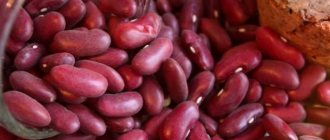Green beans have been considered a popular food product around the world since ancient times. Latin America is considered to be the birthplace of culture. It was cultivated several centuries before the birth of Christ. And only with the return of Columbus to Europe from America, the vegetable began to be grown on the Eurasian continent. In the modern world, the product is used in different cuisines around the world. There are many types of beans. It is not only tasty, but also nutritious.
The pods of the plant are rich in substances beneficial to the body. Among them are vitamins, proteins, minerals, amino acids and antioxidants. Few people know that beans slow down the aging process of the body. Nutritionists advise using a member of the legume family as food to reduce excess weight in obese individuals. The fiber contained in beans is not only healthy, improves intestinal function, but also maintains a feeling of fullness for a long time.
Gardeners value healthy, tasty vegetable crops and take good care of them. As a result, she pleases them with a rich harvest. In the summer, the harvest is always on the table and there is no need to think about its availability. However, with the arrival of autumn, experienced housewives and gardeners begin to prepare for preserving stocks of useful plants and their fruits for the winter. How to store beans for several months at home without compromising their quality?
Many thrifty housewives freeze, preserve and dry it for the winter.
If you store the fruits of dried crops for a long time at home, then small pests often infest them. How to store beans to prevent bugs at home? This point in storing beans is very important.
As a result of incorrect actions, you can lose all your supplies for the winter.
In this matter, it is necessary to follow strict rules in order to effectively store the stock in winter.
How to protect beans from bugs
A small insect that starts in an unripe pod causes significant damage to plantings. Pests become active in hot weather. The larvae settle in numbers of 20-30 individuals per bean. After this, the product becomes unsuitable either for food purposes or as seed material. To protect plants from infection by the grain beetle, you should sow intact seeds, treat the plantings with Detis or Metafox, and harvest before the pods crack.
Tips to help protect beans from bug damage:
- Harvest in the morning, carefully cutting the pods with scissors and supporting them with your hand;
- ensure the glass container is sealed;
- carry out pre-sowing soil preparation: enrich with nodule bacteria by introducing bacterial preparations or soil from the ridges on which the beans were grown;
- grow individual plants to obtain seed material, which will increase the quality and productivity of the crop.
Bean care
Growing conditions
The emerging shoots are hilled to give them stability. Subsequent bean care includes regular watering, weeding, hilling the bushes, loosening the soil, fertilizing, tying shoots to supports, as well as pinching the ends of the stems to enhance their branching and accelerate the ripening of the beans.
- Cilantro: growing at home and in the garden
Watering
Before bud formation begins, beans are watered as needed - once a week or less. You will need a lot of water, but it is difficult to name the exact amount: it all depends on the weather and soil. The soil should be moderately moist. When the seedlings develop 4-5 leaves, stop watering altogether. From the beginning of flowering, the hydration of the beans is resumed, and then the amount of water poured under the bush and the frequency of watering are gradually doubled.
The best water for beans is rainwater, but if you don't have it, fill a large container with tap water and let it sit for at least a day before watering the beans. After watering, it is most convenient to weed the weeds and loosen the rows. The first shallow loosening is carried out when the seedlings reach a height of 7 cm; after two weeks, the soil is shallowly loosened a second time, at the same time hilling up the bean bushes. The third time they loosen the soil and hill up the bushes before closing the rows of beans.
Top dressing
After the formation of the first true leaf of the seedlings, they are fed with superphosphate in the amount of 30-40 g per m², and during the budding period, potassium salt is added at the rate of 10-15 g per the same unit area. During the ripening period of the beans, you can add wood ash to the soil. It is better not to feed growing beans with nitrogen fertilizers: firstly, they are able to obtain nitrogen for themselves, and secondly, excess nitrogen fertilizers can provoke vigorous growth of greenery, and the bean harvest will be more than modest.
Garter beans
When planting climbing beans, supports up to one and a half meters high are installed, onto which wire or rope is pulled horizontally. Along these stretch marks you will guide the curly shoots of the beans. You can grow beans in nests: do not thin out the sprouting seedlings, leave them to grow as a dense bush, and drive a wooden stake nearby, along which the bean stalks will curl. Or stick 3-4 guides up to 2 m high around the bush and tie their tops together so that the shape of the support resembles an Indian wigwam. Do not use metal or plastic stakes as stakes because the beans will not climb them.
How to prepare beans for storage
To preserve most of the harvested beans for the winter, you need to pay close attention to drying, which is carried out in several stages:
- collect the pods;
- Place in a sunny, well-ventilated place. In urban conditions, beans are poured onto paper spread on a balcony or loggia;
- wait about two weeks until the pods turn yellow, open slightly, and the grains harden;
- heat the seeds intended for consumption in the oven at 60 degrees for half an hour;
- place the seed material in the freezer for a short time.
Proper processing of beans will protect against pests and destroy larvae.
The second drying option: the beans are husked and distributed over a dry surface, stirring occasionally.
Preserving beans for the winter
Before storing beans for the winter, you need to carry out the following operations:
- Dry
. When the weather is dry and sunny, the pods should be laid out on a flat surface and left in the sun until evening. After it gets dark, the beans should be placed in boxes or baskets and dried the next day.Instead, legumes pulled out from the beds can be collected in brooms and hung in a place with a good draft. The result will be the same as when dried in the sun.
- Check
the readiness of the beans for subsequent storage. The legumes are fully ripe when the pods become dry and withered, and the valves begin to open slightly. The beans should be firm to the touch. - Remove the fruits from the pods and place in prepared container
. You can use fabric bags and glass jars that close tightly.It is advisable to use metal or glass lids. Polyethylene ones are unreliable: they allow air to pass through. It wouldn’t hurt to keep bags made from natural fabric in a weak saline solution and dry them.
- Place the beans in a cool place
. The best option is a refrigerator. With the onset of frost, the legumes can be placed in another cool room.
If the described rules are followed, the beans will remain in quite suitable condition for two years.
Another method is used to help preserve legumes until the next harvest. We are talking about heating the grain:
- The beans, freed from the pods, are laid out on a baking sheet and put in the oven for about ten minutes. Temperature - 90 degrees.
- The legumes are poured into a container that can be hermetically sealed and placed in the refrigerator.
Beans prepared in this way will last for more than one winter.
Rules for storing beans to prevent bugs
Home conditions are suitable for storing a rich harvest when the necessary rules are followed. Seeds can not only overwinter, but can be preserved for several years without being damaged by pests and bugs: it is important to know how:
- Sterilize glass jars, add a little ash and fill with beans. Wash the seeds before cooking.
- Chop a few cloves of garlic and stir into the beans.
- Place large quantities of beans in boxes or boxes lined with newspapers: printing ink serves as protection against insects.
- Add a sprig of calendula, dill or rosemary to the container with beans, which repel bugs.
Choosing containers and premises: creating optimal conditions
Dry beans are placed in sealed containers: plastic bags, glass jars or plastic containers and placed in a dark, cool place with an air temperature no higher than +10 degrees and humidity up to 50%. To protect against weevil, the product is placed in the freezer and taken out to the balcony or terrace in winter. Beans do not lose their taste and nutritional characteristics after prolonged exposure to low temperatures.
Warm and moist air promotes grain germination.
If a canvas bag is chosen for storage, it must be prepared in advance: soak in a salt solution and dry. This measure serves as reliable protection against bugs.
Ideal premises for storing beans are barns, pantries and cellars with suitable temperature conditions. Loggias and basements are allowed as temporary storage, as they do not maintain constant temperature and humidity.
Where and in what to store beans
After drying, the beans should be placed in an airtight container. This can be a glass jar, plastic bag or plastic container. The main thing is that no living creature can get inside. If you are going to store beans for a long time, you can do the following. Heat the beans on a baking sheet or in a dry frying pan with a lid. Don't let the beans start to burst. After this, pour them into clean sterilized jars and close the lid. The jar should only be opened in winter.
Beans should be stored in a cool and dark place. If you are afraid that grains may appear in the beans, the beans should be kept in the cold. The grains tolerate low temperatures well and do not lose their taste and nutritional properties. Before frost sets in, beans can be kept in the freezer and then taken out to the balcony.
It is very important not to keep the beans warm - moist and warm air promotes germination of the grains. Bean sprouts are not eaten, but they can be planted (if it’s spring). If you are going to store beans in a canvas bag, first dip it in a salt solution. After this, dry the fabric without rinsing. A salty bag will protect your beans not only from grains, but also from other insects.
Frozen beans
Harvesting of asparagus beans occurs on the 14th day from the moment of flowering and continues every other day.
To preserve the pleasant taste, delicate aroma and tenderness of green beans, you will have to freeze young, freshly cut fruits for the winter. The pods are washed and removed from tails and external damage. It is possible to freeze the pods whole or in portioned pieces. To preserve the taste and beneficial properties, blanching is recommended: the pods are boiled for three minutes in boiling water and placed in cold water with ice.
How to Preserve Green Beans
Green beans have a special taste and delicate aroma. If you want to preserve the delicate spring flavor of young beans, you can simply freeze them.
To freeze, you need to take fresh, just picked pods. Green bean pods should be thoroughly washed and the tails cut off. You also need to cut out all the black spots and damage on the surface of the pod. If you cut the beans into small pieces before cooking, do so. Bean pods can be frozen whole without cutting.
Then the beans need to be blanched. Place the beans in boiling water for three minutes and place a large cup of ice next to them. When the three minutes are up, remove the beans from the boiling water and plunge into ice water. This method of processing beans will preserve maximum beneficial properties and taste.
Beans must be thoroughly dried before freezing. Place the processed bean pieces on a clean napkin and allow excess water to drain. Otherwise, ice crystals will form on the beans, which will deprive the green beans of their special flavor. After drying, distribute the pods into bags so that if necessary, take only one portion and do not defrost the excess.
Beans are a tasty and nutritious product that is used in many dishes. Vegetarians cannot imagine life without beans, because these beans can be compared with meat in terms of the amount of protein. Regular consumption of beans helps improve the functioning of the kidneys, gastrointestinal tract, and nervous system. If you eat beans often, you won't be afraid of plaque and tartar. Plant and grow beans, protect the crop from bugs, and then you can enjoy the taste and nutritional value of this product all year round.
Storage at room temperature
Properly prepared bean products can overwinter in a room. A certain amount of the harvest can be placed in the refrigerator, the remaining beans are frozen for three hours in plastic bags in the freezer. After this, the seeds need to be dried.
In order to get rid of bugs, the beans are cooked in a slightly open oven at 100 degrees for 20 minutes. The container should be tightly closed and located in a dry, dark, and well-ventilated place such as a kitchen cabinet or table. Ambient humidity should be low and room temperature moderate.
Necessary steps when storing beans at home:
- culling of fruits with black dots;
- peeling of pods;
- getting rid of seeds with plaque on the surface.
- wash the beans before placing them in containers;
- use containers that can accumulate condensate;
- organize storage near a heat source.
Saving bean seeds at home
How to store beans for seeds in winter is a different story.
Pods with intact leaves and without the slightest flaws are selected. After drying in the sun, the beans in pods are packed in a canvas bag and kept in the refrigerator until cold weather sets in. Later, the bag is taken out into the cold and hung up so that rodents do not eat it. The pods are disassembled before planting. Another way to store seeds is to sprinkle them with ash and store them in an airtight glass container. By adding a head or several cloves of garlic to the package, the safety guarantee increases. There are several ways to store beans at home for the winter. Ambient air humidity should be no more than 50%, and the temperature that stops biological development should be 10 0, that is, before the onset of frost, the storage place is in the refrigerator. Store in linen bags, you can put a garlic head inside.
If there are a lot of beans, they can be stored in cardboard boxes or wooden boxes, but inside there should be a layer of ordinary black and white newsprint. Printing ink also prevents insects from settling in. Of course, winter storage in a cold place will guarantee the safety of the product.
Another way to preserve beans for the winter is to use heating of commercial grain. When heated in the oven to 90 0 for several minutes, the beneficial properties of the beans will be preserved, but the contents will die. After this treatment, in dry containers with airtight lids, the beans will last for more than one winter. Another way is to heat it at 10 0 for an hour.
The lids under which beans are stored can be glass or metal. Polyethylene - breathable. Linen storage bags must first be soaked in a saline solution and dried.
If beans are stored in a warm, open place without moisture, the beans may sprout or become moldy. Bean sprouts should not be consumed. It can be used as planting material if the time for sowing has come.
Proper storage of beans - video
Terms and conditions
The main requirement for storing this legume is maintaining a certain temperature and humidity: the shelf life of the product largely depends on these parameters.
Other factors also influence the shelf life of beans:
- Tara. It is preferable to use bags made of natural fabric, cardboard boxes, and wooden boxes.
- Conditions. Bugs multiply in warm conditions, so you should ensure a low temperature in the storage area, which will protect against pest damage and preserve the shell. The bean weevil lays up to two hundred eggs at a time and destroys reserves in a short period of time. Optimal room temperature: +5 – +10 degrees. If the indicators rise higher, you need to lower them or provide the products with cool storage. High humidity (more than 50%) is unacceptable, the grains become moldy, absorb the smell of dampness, and lose their presentation.
- Duration. The period for storing beans at home to prevent bugs from infesting them is largely determined by the container. If the rules are followed, canvas bags and wooden boxes can store legumes for two to three years. The processed product, in hermetically sealed glass jars, retains its consumer properties for up to 8 years.
If the housewife is thinking about an alternative way to preserve the harvest, with reliable protection against the appearance of insidious bugs, canning is suggested. Beans prepared in this way are suitable for consumption for two years. The preparation will serve as a help for the cook, because it is used as a side dish and component of first courses, salads or stews.
By familiarizing yourself with the rules and options for home storage, you can expand the area for growing this healthy vegetable crop.
Beans are a tasty and healthy vegetable, which in terms of protein content is equivalent to meat. Bean dishes are nutritious and high in calories, good for eating as first and second courses during Lent and beyond. But housewives are faced with problems storing legumes after harvesting or purchasing a packaged bag from the store. Bugs often infest beans.
Green beans for the winter
Green beans for the winter
Amalia_anomalia » Fri Aug 20, 2010 8:08 pm
The first option is to dry the beans
The second option is to freeze it.
If it’s strange for you to think about what you can cook with dry green beans, then let me tell you that there are many recipes.
For example, my recipes include “Spring” salad with dry beans.
cut the beans on one side, but not all the way.
pass the beans with a needle onto a thick thread, and continue until the beans are finished.
tie the ends of the thread and hang it away from the rays of the sun, because the rays will turn it yellow. Dry it completely like this, then put it in a fabric bag for storage and store it until winter. When you cook, put it in warm water, then use it.
Amalia_anomalia Messages: 2788 Registered: Nov 7, 2009 From: Armenia, Yerevan Thanked: 354 times. Thanked: 997 times. Name: Amalia
elen-erm » Fri Aug 20, 2010 10:09 pm
elen-erm Messages: 391 Registered: Jul 30, 2010 From: Russia, Nizhny Tagil Thanked: 145 times. Thanked: 237 times. Name: Elena
Amalia_anomalia » Fri Aug 20, 2010 10:45 pm
Even this year we don’t have any fruit, I can’t make dried fruit. There are but they are expensive, I will probably only make them from watermelon, melon, apples and pears.
Try it, dear. thank you for your visit
Amalia_anomalia Messages: 2788 Registered: Nov 7, 2009 From: Armenia, Yerevan Thanked: 354 times. Thanked: 997 times. Name: Amalia
mama_Olik » Fri Aug 20, 2010 10:57 pm
mama_Olik Messages: 2261 Registered: Dec 28, 2009 From: St. Petersburg Thanked: 1865 times. Thanked: 1670 times. Name: Olga
Tsvetik19 » Sat Aug 21, 2010 5:25 am
Amalia, tell me, how much to scare in terms of time or appearance? I’ve just never dealt with fresh beans, only in jars.
Tsvetik19 Messages: 106 Registered: Feb 4, 2010 From: Baikal Thanked: 540 times. Thanked: 20 times. Name: Svetlana
Amalia_anomalia » Sat Aug 21, 2010 9:17 am
Amalia_anomalia Messages: 2788 Registered: Nov 7, 2009 From: Armenia, Yerevan Thanked: 354 times. Thanked: 997 times. Name: Amalia
MOROZOVA » Sat Aug 21, 2010 9:25 am
And your recipe is just with blanching. Everything should be fine
MOROZOVA Messages: 37 Registered: July 23, 2010 From: Zaporozhye Thanked: 2 times. Thanked: 7 times. Name: Natalya
Amalia_anomalia » Sat Aug 21, 2010 9:30 am
Amalia_anomalia Messages: 2788 Registered: Nov 7, 2009 From: Armenia, Yerevan Thanked: 354 times. Thanked: 997 times. Name: Amalia
MOROZOVA » Sat Aug 21, 2010 10:00 am
MOROZOVA Messages: 37 Registered: July 23, 2010 From: Zaporozhye Thanked: 2 times. Thanked: 7 times. Name: Natalya
begi » Sun Aug 22, 2010 6:08 am
begi Messages: 1651 Registered: June 27, 2010 From: Moscow Thanked: 2090 times. Thanked: 2788 times. Name: Valentina
Amalia_anomalia » Mon Aug 23, 2010 8:50 am
Amalia_anomalia Messages: 2788 Registered: Nov 7, 2009 From: Armenia, Yerevan Thanked: 354 times. Thanked: 997 times. Name: Amalia
stellaallets » Wed Sep 08, 2010 5:58 pm
stellaallets Messages: 89 Registered: Sep 1, 2010 Thanks: 19 times. Thanked: 57 times. Name: stella
Amalia_anomalia » Wed Sep 08, 2010 8:07 pm
Mom even dries the eggplant peels.
Amalia_anomalia Messages: 2788 Registered: Nov 7, 2009 From: Armenia, Yerevan Thanked: 354 times. Thanked: 997 times. Name: Amalia
stellaallets » Thu Sep 09, 2010 4:22 pm
stellaallets Messages: 89 Registered: Sep 1, 2010 Thanks: 19 times. Thanked: 57 times. Name: stella
stellaallets » Thu Sep 09, 2010 4:24 pm
stellaallets Messages: 89 Registered: Sep 1, 2010 Thanks: 19 times. Thanked: 57 times. Name: stella
29 Jun 2021 edypravilno 126
Bookmark for storage
Beans can be eaten at the time of milky ripeness, when the pods are still green. It has not fully formed, but is suitable for cooking and requires little time for cooking. To harvest the crop and store it, experienced gardeners wait until the pods are completely dry with the valves partially opening. This means the vegetable is ready to be removed. Before storing, housewives trying to preserve their crops from pests:
- The beans are shelled, carefully sorted and inspected to ensure there are no holes in the grain.
- Beans with noticeable defects are not stored and either thrown away or consumed immediately.
During the harvesting period, the beans are wet and require drying, without which:
- spoil quickly;
- shrink during storage;
- are attacked by pests.
Prevention of beetles
To preserve the harvest for food and seed for planting next year, housewives use a number of measures that help, if not kill harmful insects, then reduce the damage caused and prevent their reproduction. This is done using:
- warming up;
- vacuum storage;
- low storage temperatures;
- special processing of packaging material.
Planting beans in open ground
When to plant
They begin to sow beans in May, when the soil at a depth of 10 cm warms up to 12-15 ºC. It is advisable to wait until the spring frosts have passed. A sign that will tell you that the time has come to plant beans is the flowering of the chestnut tree. Climbing bean varieties are planted a week later than erect ones. Bush beans can be grown as a second crop after harvesting vegetables that are ripe by early July.
- How to transplant phalaenopsis correctly
Beans can be sown in several stages: every 10 days from mid-May to early July. Many people grow beans and peas around apple trees, which protect the beans from the cold wind. Before planting beans, it is necessary to carry out preparatory treatment of the soil and seed. On the eve of planting, the seeds are sorted, soaked in water overnight to swell, and in the morning, just before planting, dipped for 5 minutes in a solution of boric acid (1 g per 5 liters of water) - this measure will protect the seeds from insect pests and many diseases.
Soil for beans
Beans do not grow well in clay soils through which water drains slowly, and beans are harmed by soil that is too wet. Beans do not like soils overloaded with nitrogen, since they themselves are able to extract it from the air. It is best to choose sunny, wind-protected areas with light, fertile, permeable soil, deep groundwater and a pH of 6-7 units for beans. If there are areas in your garden with depleted soil that has not been fertilized for a long time, plant beans there, since they, like many legumes, are an excellent green manure and a precursor for all vegetable crops.
The soil for beans is prepared in the fall: the area is dug up to the depth of a spade bayonet, adding for each m² 4 kg of humus or compost, 2 tablespoons of dolomite flour, one spoon of ammonium nitrate and double superphosphate, half a tablespoon of potassium chloride or potassium soda . Or: half a bucket of humus or compost, 30 g of superphosphate and 20 g of wood ash per 1 m².
Then you can plant beans
Beans grow well after crops such as cabbage, tomatoes, potatoes, eggplants, peppers and cucumbers. It is not advisable to plant beans in areas where legumes grew (peas, lentils, soybeans, peanuts, beans and beans themselves) - after such predecessors, beans are planted on the area no earlier than three to four years. Good neighbors for beans are carrots, beets, onions, as well as tomatoes, cucumbers and cabbage.
How to plant in the ground
Bush varieties of beans are sown to a depth of 5-6 cm with an interval of 20-25 cm between bushes and row spacing up to 40 cm wide. Climbing varieties are sown less frequently: 25-30 cm between specimens and row spacing about half a meter wide. Place 5-6 beans in a hole. When the shoots appear, leave only three strong seedlings in the bush and transplant the rest. After planting, the bed is watered and the soil is compacted with the back of the rake. If you are afraid that night frosts may return, cover your crops with film.
Pests
The bean weevil photo is a gray-brown beetle, 2 to 5 mm long. There are several reasons for bean pests to enter the house:
- from the garden;
- from the shop;
- from neighboring cereals.
In summer, the beetle pierces the valves of legume pods and lays eggs inside. The larva gnaws the insides of the fruit, then turns back into a beetle, and the process is repeated again and again until the insect completely destroys the crop if drastic measures are not taken. The bean weevil can live without food for about 3 months and fly long distances.
In the southern regions, the beetles go into the ground for the winter, and in the northern regions they remain inside the grain. Infected beans can be identified by neat little holes. When storing beans at room temperature, pests confuse the season and begin to actively multiply and destroy the crop. Disdainful housewives, when they discover uninvited guests, eat this product. First, they get rid of the bugs in the beans by soaking the affected fruits in a strong saline solution, then bring the water to a boil. Disturbed by the irritating liquid, the beetles and their larvae hastily leave their “dining rooms” and die. The beans are washed under running water and dishes are prepared from them. It tastes no different from the intact one. Housewives who are less economical, if there are bugs in the beans, simply throw them away.
Sprout fly
The sprout fly is gray in color with stripes on the back and measures about 5 mm in size. The fly's flight begins in the first half of May at air temperatures above +10 degrees. The first generation causes the greatest damage to the crop. The insect lays eggs in the soil, from which larvae emerge a week later and gnaw through the planted and swollen bean seeds.
To prevent the germ fly larvae from bothering you, you fight them:
- Beans are sown at air temperatures below +10 degrees.
- Prepare a repellent mixture and sprinkle the beds with bean crops, loosening the soil a little. The mixture consists of 200 g of ash. 1 tsp. tobacco dust, 1 tsp. hot pepper.
- The seedlings are watered with saturated salt solutions. 250 g of cooking layers are dissolved in 10 liters of water and watered the ground during the emergence of the larvae.
- The sprouts are watered with garlic infusion prepared from 400 g of ground garlic, infused in hot water (50-60 degrees) for 24 hours.
- If traditional methods do not help, to get rid of a harmful insect, use insecticides (preparations for controlling harmful insects, such as Decis, Fufanon). They can be used before the beans bloom.
Bean diseases
In addition to pests, during cultivation, beans are subject to various bacterial and fungal diseases and root rot. Rusty spots appear on the leaves, pods and roots, which then turn black. To combat diseases, use a 1% solution with Bordeaux mixture. To reduce the incidence of legume diseases, the beans are treated before planting. It is soaked in:
- 1% solution of potassium permanganate;
- a solution of baking soda, prepared and 1 tsp. soda and 1 liter of water;
- 3% hydrogen peroxide.
Pests and diseases
The plants that most often damage the plant are bean weevils, cabbage cutworms and garden cutworms. Cutworms lay eggs on the ground parts of beans, and the larvae that hatch from them begin to devour the greens, flowers and fruits of the plant. The bean kernel is a bug that enters the soil along with the seeds and destroys the beans from the inside.
What is wrong with beans? With poor care and violation of agrotechnical conditions, beans are affected by anthracnose, bacteriosis and viral mosaic. Bacteriosis is dangerous because its pathogens not only cause harm to plants and even lead to their death, but can also remain viable for many years and develop in crop residues and in the soil. Anthracnose manifests itself as brown depressed spots of irregular or round shape on seedlings, the veins on the leaves become brown, the plates turn yellow, holes form on them, and they die. Red, reddish or brown spots appear on the fruits, turning into ulcers as the disease progresses. Mosaic is characterized by the appearance of necrotic spots and discoloration of veins on bean leaves.
Bean processing
When asked how to treat beans against viral mosaic, we sadly answer: nothing. The viral disease cannot be treated, but it can be avoided if you organize proper care for beans, observe crop rotation and take the preparation of seed seriously. As for anthracnose and bacteriosis, proper care plays an equally important role in the fight against these diseases, and you can get rid of diseases by removing and obligatory burning of diseased plants or their affected parts and treating the beans and the area with one percent Bordeaux mixture.
- Eggshells as fertilizer for garden plants
But before you treat the beans with a fungicide, think about whether it would be better to make it a rule to carry out preventive spraying of the beans and the area against fungal diseases? Treatment of beans and the soil around them with Fitosporin is carried out in the spring, when the seedlings reach a height of 12-15 cm, and after harvesting. This measure, if you follow agricultural practices and crop rotation, can make your beans invulnerable.
As for the fight against insects, you can prevent the appearance of cutworms by deep digging the soil on the site in the fall, but if they do appear in the spring, and there are many of them, you will have to treat the beans with a one-percent solution of Bitoxibacillin or a half-percent solution of Gomelin, which are bacterial preparations. You can prevent bean grains from appearing on your site by carefully sorting out the seeds before sowing, soaking them to swell and subjecting them to pre-sowing treatment with boric acid.
There are bugs
If there are beetles in beans, you need to do the following:
- understand the scale of the disaster;
- if the damage is minor, sort through and remove visible pests;
- heat at 60 degrees for 1 hour in the oven or pour in a concentrated salt solution and boil;
- if all the fruits are damaged, it is better to throw them away;
- transfer to a small bag and freeze raw;
- Rinse under running water, cook and freeze the cooked beans in portions.
Beans are a tasty, healthy and nutritious vegetable that can replace meat in terms of protein content. To grow it, no special skills or knowledge are required. The main problem in preserving the crop is the correct methods of preparation for storage and preventive measures and cold storage. Then the percentage of losses will decrease significantly or will not exist at all.
Legumes occupy an important place in the human diet. Beans are used for preparing first courses and side dishes and are grown both on an industrial scale and in household plots. Perhaps this is the most popular type of legume in our country. Each owner tries to preserve his harvest and protect his crops from numerous pests and diseases. How can we make sure that the crop grows without problems and is stored for as long as possible? There are many ways to prevent beans from getting bugs.
How to store beans in winter
Many housewives, not relying on the fact that beetle larvae will sleep at low temperatures, choose a more reliable way to store beans in winter. Bean grains are cooked in an oven heated to 80-90°C for 4-5 minutes. After such heating, harmful insects die if they were there, and the beans can be placed in dry glass jars and tightly closed. To prevent the appearance of other legume pests, you can throw garlic in a jar and put it in a cold place. After calcination, the grains are not suitable for planting, but they can be stored for eating for a very long time. Such reinsurance is completely justified, because it is difficult to immediately notice the pest in the grains, and as a result, how much valuable product is eaten by insatiable larvae, how much money, labor and time is wasted!
Recently, green beans, also known as green beans, have become popular in household plots. Therefore, the question of how to store green beans is quite relevant, if even in the refrigerator the pods remain fresh for only a couple of days. To take advantage of the beneficial properties of green beans in winter, you can freeze them, and do it correctly, following the technological process. Before freezing, green beans are blanched, after cutting off the ends and cutting them in half, dried, placed in an airtight bag and only then placed in the freezer. How long to store beans frozen is up to the housewife to decide, but their valuable qualities last for six months. In addition to freezing fresh pods, there are many options for storing beans at home - pickling, canning, salting, drying. There are so many housewives - there are so many recipes. You can prepare many different dishes from canned beans in winter. Considering all the secrets of storing beans, you can prepare delicious bean soups, green bean salads or hearty bean cutlets all year round.
Other site materials
How to store turnips in the basement
To properly preserve turnips, you need to maintain a certain temperature regime.
Shelf life of sour cream
In order for sour cream to remain tasty throughout its shelf life, you need to observe the correct storage conditions.
Salads with mayonnaise shelf life
Each salad has its own shelf life and shelf life. Learn all about properly storing your favorite salads
How to store cauliflower in the cellar in winter
Do you want to eat healthy and tasty cauliflower all year round? Read our best article on storage!
How long can you store herring under a fur coat in the refrigerator?
We invite you to learn more about storing ready-made salads in the refrigerator from our new article
How to properly store cognac in bottles
Bottled cognac requires special attention and care during storage
Where do insects come to us from?
It is not difficult to find out where the pests came from. All kinds of bugs are introduced with store-bought cereals, pasta, and flour. They settle in cracks and multiply quickly. It is impossible to follow this process. Another option is that they come to warm rooms to escape the cold. This is why it is recommended to keep legumes cool.
Important! If the beans are poorly sorted before planting, the risk of acquiring unwanted tenants increases greatly.
How to fight?
Housewives often don’t know what to do with bugs in beans. Care will protect you from serious crop losses. Legumes need to be sorted often. If the bugs have just appeared and have not yet had time to spoil many grains, cold or hot air treatment will help. Severely affected grains are immediately discarded. The rest of the beans are placed in the freezer or oven for a while.
When exposed to extremely low or high temperatures, the larvae will not survive.
Small household tricks can also help protect legumes. For example, grains do not tolerate strong odors, so it is useful to put garlic cloves in their husks in bags of beans. In the room where legumes are stored, cloves, bay leaves or nutmeg are often placed.
Important! Bean storage containers are periodically sanitized. This is an effective preventive measure.











